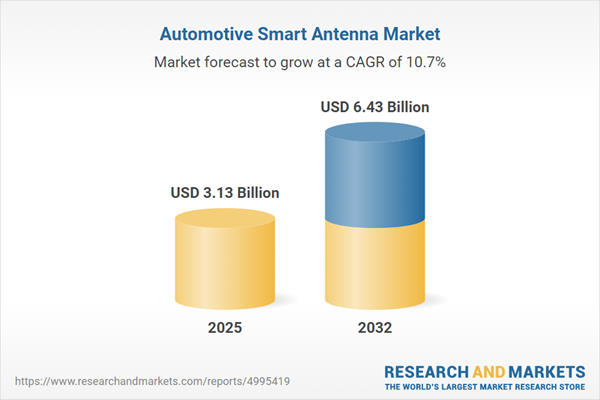Speak directly to the analyst to clarify any post sales queries you may have.
The automotive smart antenna market is experiencing robust transformation, driven by shifting vehicle architectures, regulatory expectations, and rising connectivity demands. Senior executives need a comprehensive view of how technology, supply chain, and regional dynamics converge to shape this sector’s future.
Market Snapshot: Automotive Smart Antenna Market Growth and Outlook
The Automotive Smart Antenna Market grew from USD 2.84 billion in 2024 to USD 3.13 billion in 2025. It is expected to continue growing at a CAGR of 10.72%, reaching USD 6.43 billion by 2032.
This rapid growth reflects the mounting need for integrated connectivity, advanced driver assistance, and data-centric vehicle ecosystems. Accelerating advancements in vehicle-to-everything communication, electrification, and modular network platforms are redefining value creation for automakers, suppliers, and technology firms targeting the automotive smart antenna market.
Scope & Segmentation: Diverse Technologies and Market Coverage
This report provides a detailed overview of the core components, frequencies, technologies, and regional variations shaping the smart antenna landscape. It dissects the critical technologies, deployment channels, and stakeholders influencing adoption and innovation.
- Antenna Types: Embedded antenna, rod antenna, shark fin antenna
- Component Types: Connectors, digital bus, electronic control units, transceivers, wiring harnesses
- Frequency Ranges: High frequency, ultra high frequency, very high frequency
- Applications: ADAS and autonomous driving, infotainment systems, navigation and telematics, remote diagnostics, vehicle-to-everything (V2X) communication
- Vehicle Types: Commercial vehicles, electric vehicles, passenger vehicles
- Sales Channels: Aftermarket, original equipment manufacturers (OEM)
- Regional Coverage: Americas (United States, Canada, Mexico, Brazil, Argentina, Chile, Colombia, Peru), Europe, Middle East & Africa (United Kingdom, Germany, France, Russia, Italy, Spain, Netherlands, Sweden, Poland, Switzerland, UAE, Saudi Arabia, Qatar, Turkey, Israel, South Africa, Nigeria, Egypt, Kenya), Asia-Pacific (China, India, Japan, Australia, South Korea, Indonesia, Thailand, Malaysia, Singapore, Taiwan)
- Company Analysis: Airgain, Amphenol, Antenova, Aptiv, Autotalks, Calearo, Continental, Ficosa, Harman, Infineon, Kyocera AVX, LYNwave, Molex, Murata, NXP, Siemens, STMicroelectronics, Taoglas, TDK, TE Connectivity, Ericsson, World Products, Yageo, Yokowo, Zhejiang JC Antenna
Key Takeaways for Decision-Makers
- Automotive smart antennas have evolved into central nodes for connected mobility, enabling seamless vehicle interaction with infrastructure, cloud services, and other road users.
- Modular, software-updatable solutions address diverse integration needs, supporting both retrofit and new vehicle platforms for a scalable approach to innovation.
- Integration of multiple frequency bands and active signal processing in compact modules supports advanced driver assistance and immersive infotainment, while ensuring high reliability under varying operational conditions.
- Regional strategies adapt to distinct regulatory environments, with local production and strategic alliances proving essential for addressing trade barriers and supply chain uncertainties.
- Collaborations among OEMs, technology vendors, and telecom operators are central to accelerating certification, harmonizing standards, and delivering end-to-end connectivity solutions across global markets.
Tariff Impact and Strategic Sourcing
North American trade policies have introduced new component import duties, compelling market participants to diversify supplier bases, invest in regional hubs, and embrace flexible manufacturing. This strategy not only mitigates tariff exposure but also enhances supply chain transparency and operational resilience. Design modularization is increasingly vital to support cost structures and accommodate fluctuating sourcing scenarios.
Automotive Smart Antenna Market Research Methodology
This research adopts an integrated approach, combining primary interviews with automotive technology leaders, system integrators, and regulatory experts. Secondary analysis includes technical literature review, patent analysis, and regulatory documentation. Data triangulation and scenario testing underpin the analytical rigor, ensuring robust, actionable intelligence for strategic planning.
Why This Report Matters to Automotive Strategy Leaders
- Identifies how evolving architectures and communication protocols can impact technology and investment priorities across varied regions.
- Enables proactive supply chain and technology decisions by quantifying the effects of policy changes and regional shifts.
- Supports competitive positioning by mapping key players, innovation trajectories, and growth hotspots in the automotive smart antenna market.
Conclusion
Automotive smart antennas are fundamental enablers of next-generation mobility, shaping performance, safety, and connectivity outcomes. Strategic integration, robust sourcing, and ongoing cross-industry collaboration are crucial for capturing evolving opportunities in global markets.
Additional Product Information:
- Purchase of this report includes 1 year online access with quarterly updates.
- This report can be updated on request. Please contact our Customer Experience team using the Ask a Question widget on our website.
Table of Contents
3. Executive Summary
4. Market Overview
7. Cumulative Impact of Artificial Intelligence 2025
Companies Mentioned
The companies profiled in this Automotive Smart Antenna market report include:- Airgain, Inc.
- Amphenol Corporation
- Antenova Limited by discoverIE Group plc
- Aptiv PLC
- Autotalks Ltd. by Qualcomm Incorporated
- Calearo Antenne SPA
- Continental AG
- Ficosa Internacional SA
- Harman International Industries, Inc. by Samsung Electronics Co., Ltd.
- Infineon Technologies AG
- Kyocera AVX Components Corporation
- LYNwave Technology Ltd.
- Molex LLC
- Murata Manufacturing Co., Ltd.
- NXP Semiconductors
- Siemens AG
- STMicroelectronics N.V.
- Taoglas Limited
- TDK Corporation
- TE Connectivity, Ltd.
- Telefonaktiebolaget LM Ericsson
- World Products Inc.
- Yageo Corporation
- Yokowo Co., Ltd.
- Zhejiang JC Antenna Co., Ltd
Table Information
| Report Attribute | Details |
|---|---|
| No. of Pages | 183 |
| Published | November 2025 |
| Forecast Period | 2025 - 2032 |
| Estimated Market Value ( USD | $ 3.13 Billion |
| Forecasted Market Value ( USD | $ 6.43 Billion |
| Compound Annual Growth Rate | 10.7% |
| Regions Covered | Global |
| No. of Companies Mentioned | 26 |









